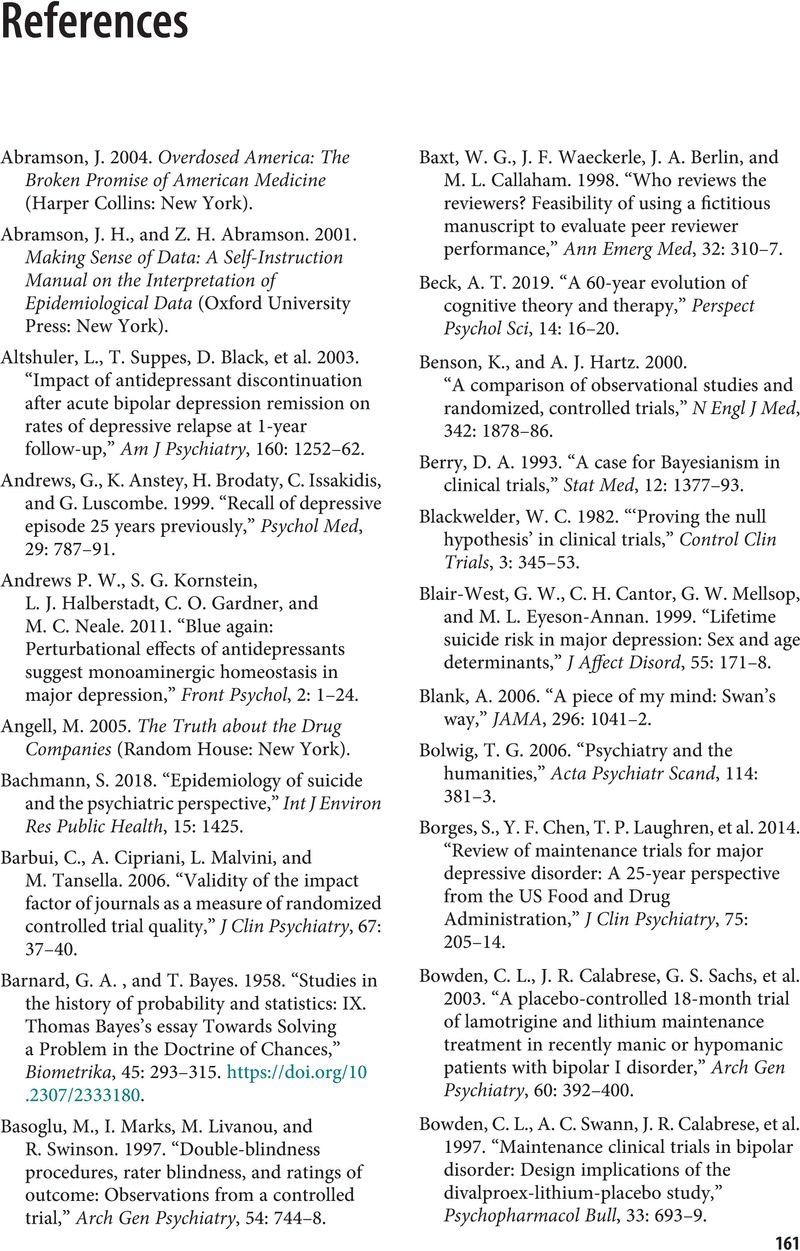Book contents
- A Clinician’s Guide to Statistics in Mental Health
- A Clinician’s Guide to Statistics in Mental Health
- Copyright page
- Dedication
- Dedication
- Contents
- Preface
- Acknowledgments
- Chapter 1 Why Data Never Speak for Themselves
- Chapter 2 Why You Cannot Believe Your Eyes
- Chapter 3 Levels of Evidence
- Chapter 4 Bias
- Chapter 5 Randomization
- Chapter 6 Clinical Trials: Improving on Clinical Experience
- Chapter 7 P-Values: Uses and Misuses
- Chapter 8 Forget P-Values: The Importance of Effect Sizes
- Chapter 9 Understanding Placebo Effects
- Chapter 10 Understanding Confidence Intervals
- Chapter 11 Observational Studies
- Chapter 12 The Alchemy of Meta-Analysis
- Chapter 13 Bayesian Statistics: Why Your Opinion Counts
- Chapter 14 Causation
- Chapter 15 A Philosophy of Statistics
- Chapter 16 Evidence-Based Medicine: Defense and Criticism
- Chapter 17 Social and Economic Factors: Peer Review, Funding, and the Conventional Wisdom
- Chapter 18 The New Canon of Psychopharmacology (STAR*D, STEP-BD, CATIE): How Clinical Trials Are Misinterpreted
- Chapter 19 How to Analyze a Study
- Chapter 20 False Positive Maintenance Clinical Trials in Psychiatry
- Appendix Understanding Regression
- References
- Index
- References
References
Published online by Cambridge University Press: 20 January 2023
- A Clinician’s Guide to Statistics in Mental Health
- A Clinician’s Guide to Statistics in Mental Health
- Copyright page
- Dedication
- Dedication
- Contents
- Preface
- Acknowledgments
- Chapter 1 Why Data Never Speak for Themselves
- Chapter 2 Why You Cannot Believe Your Eyes
- Chapter 3 Levels of Evidence
- Chapter 4 Bias
- Chapter 5 Randomization
- Chapter 6 Clinical Trials: Improving on Clinical Experience
- Chapter 7 P-Values: Uses and Misuses
- Chapter 8 Forget P-Values: The Importance of Effect Sizes
- Chapter 9 Understanding Placebo Effects
- Chapter 10 Understanding Confidence Intervals
- Chapter 11 Observational Studies
- Chapter 12 The Alchemy of Meta-Analysis
- Chapter 13 Bayesian Statistics: Why Your Opinion Counts
- Chapter 14 Causation
- Chapter 15 A Philosophy of Statistics
- Chapter 16 Evidence-Based Medicine: Defense and Criticism
- Chapter 17 Social and Economic Factors: Peer Review, Funding, and the Conventional Wisdom
- Chapter 18 The New Canon of Psychopharmacology (STAR*D, STEP-BD, CATIE): How Clinical Trials Are Misinterpreted
- Chapter 19 How to Analyze a Study
- Chapter 20 False Positive Maintenance Clinical Trials in Psychiatry
- Appendix Understanding Regression
- References
- Index
- References
Summary

- Type
- Chapter
- Information
- A Clinician's Guide to Statistics in Mental Health , pp. 161 - 168Publisher: Cambridge University PressPrint publication year: 2023

